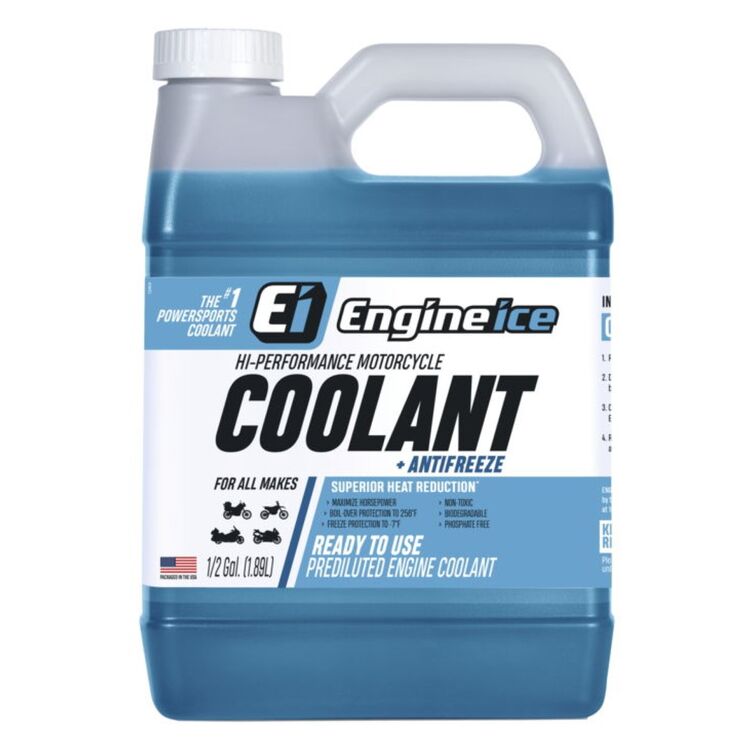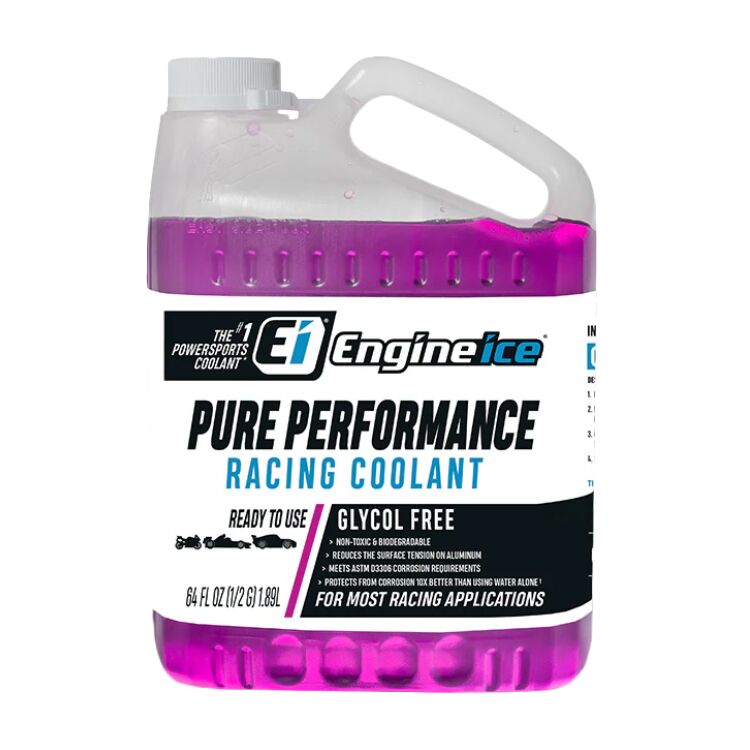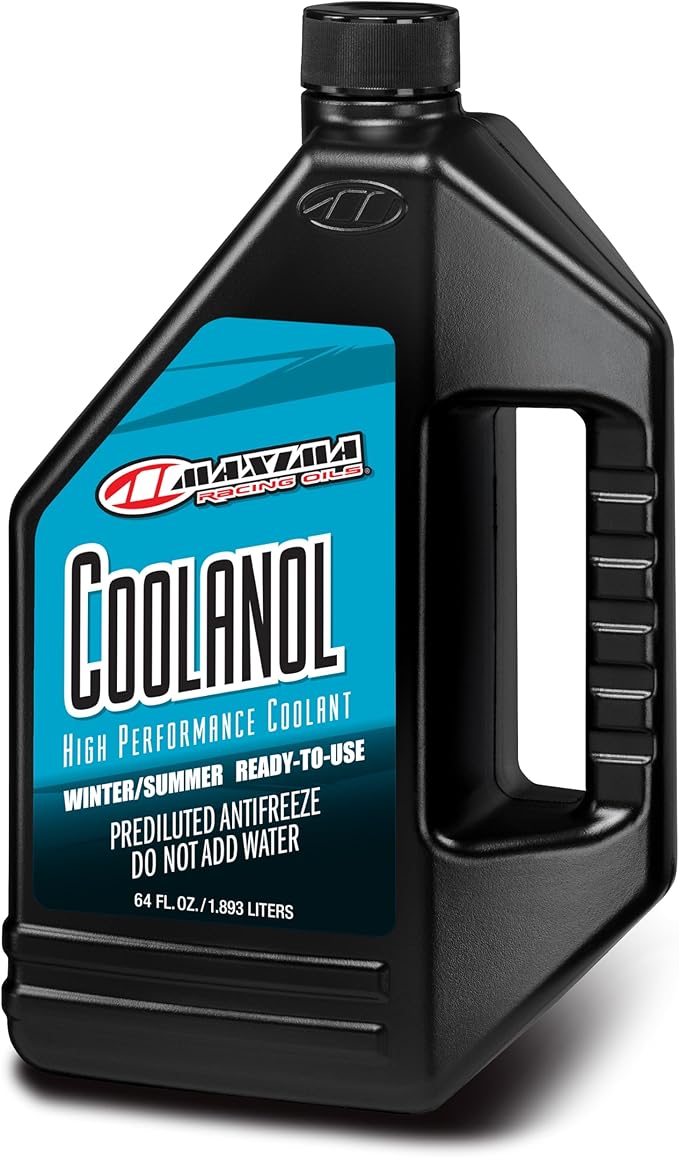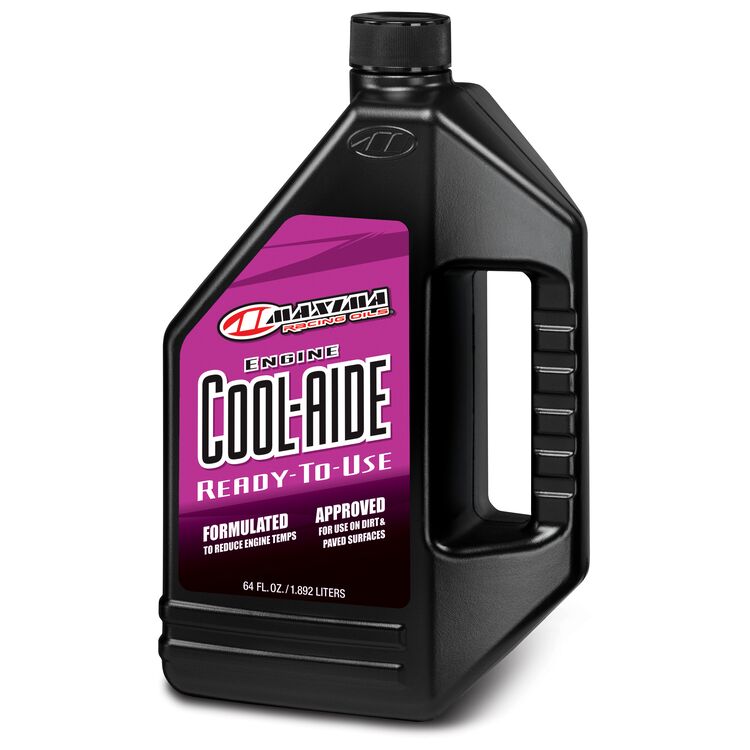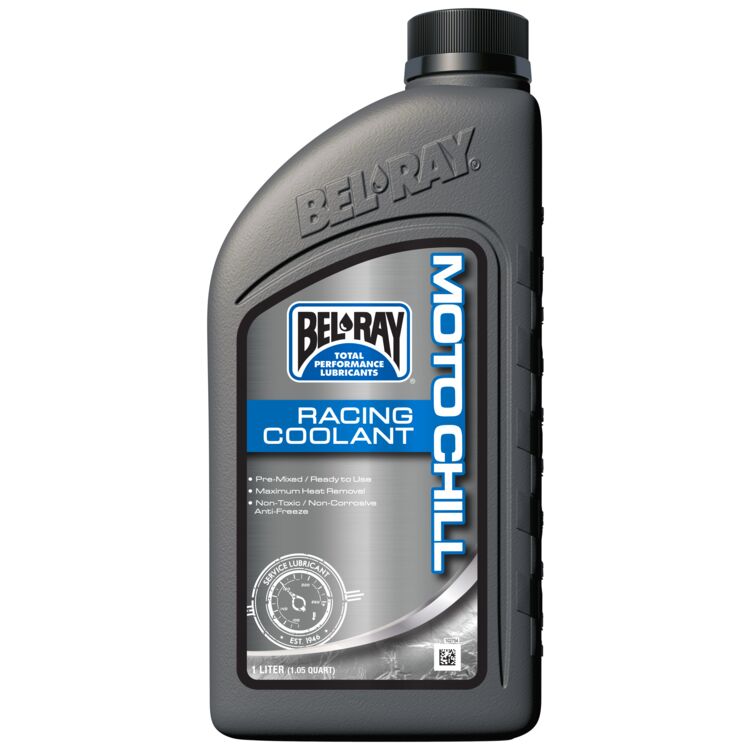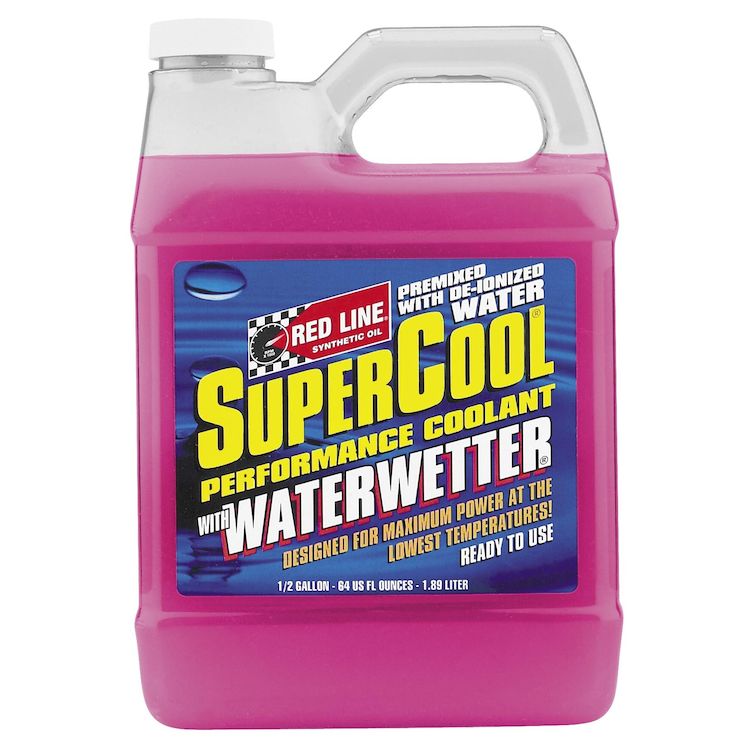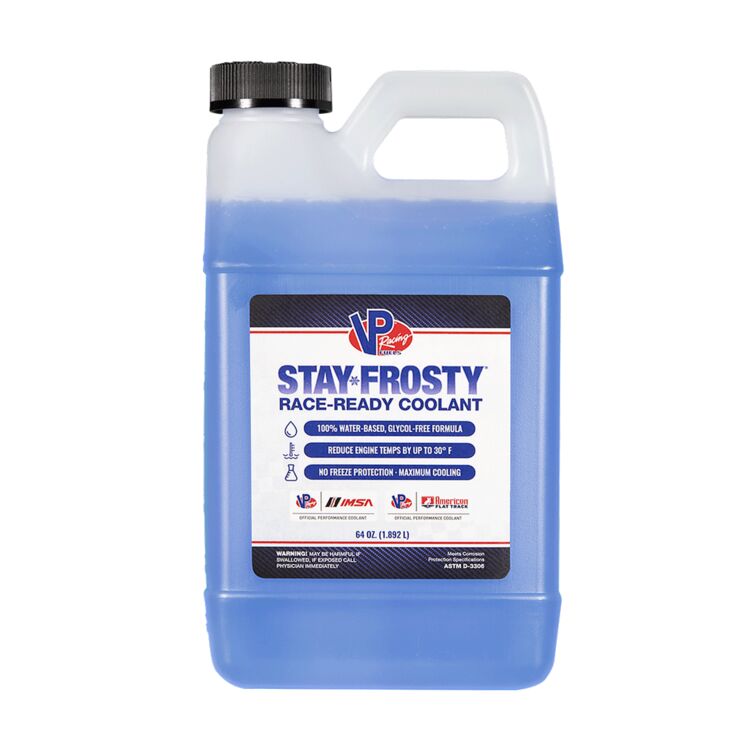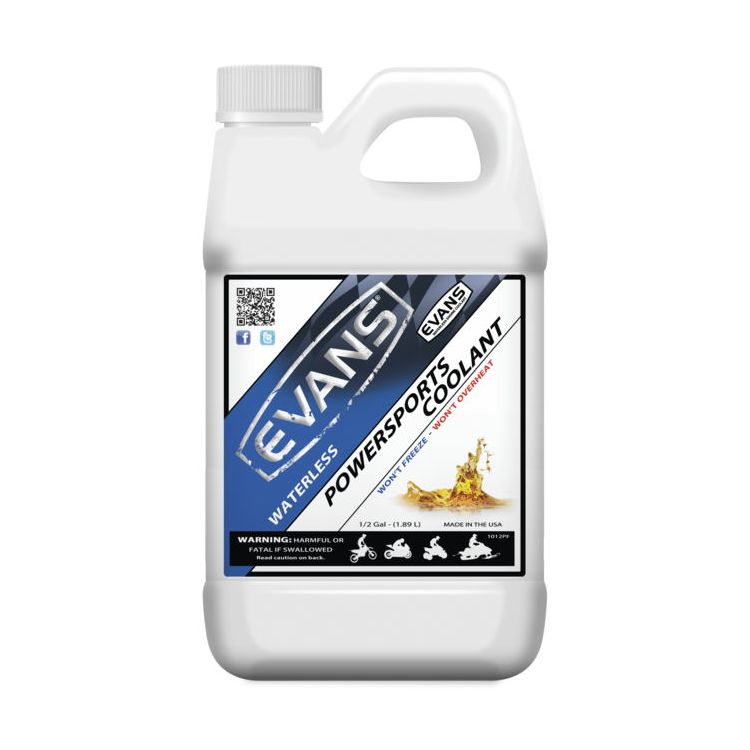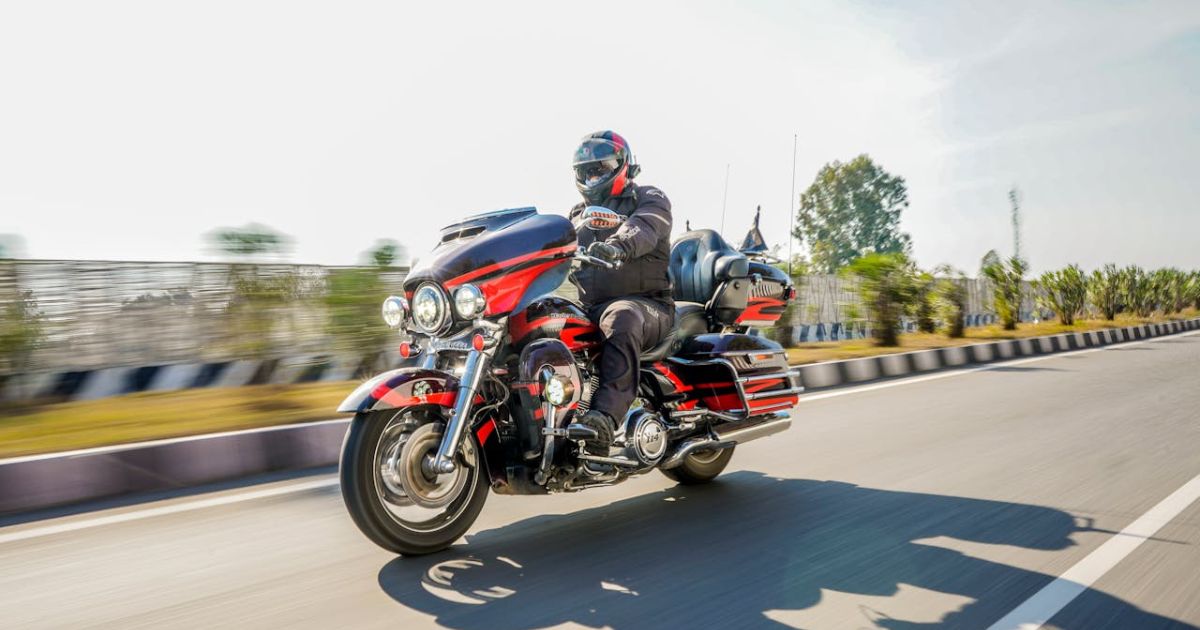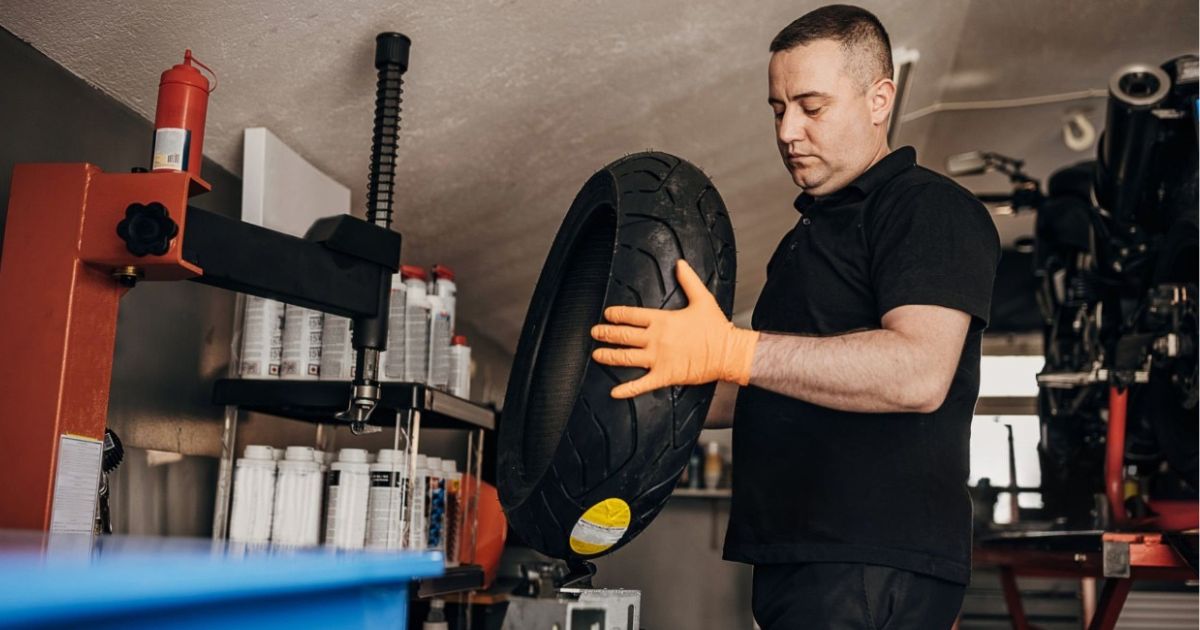
Best Motorcycle Coolant: Keep Your Engine Ice-Cool
left for contents
Your motorcycle’s engine lives a hard life. Hot days, stop‑and‑go traffic and long climbs heat it up quickly. Let the cooling system fail and you’re stuck by the side of the road or worse — staring at a glowing red temperature light. Choosing the right coolant keeps your bike happy and helps you ride farther without drama.
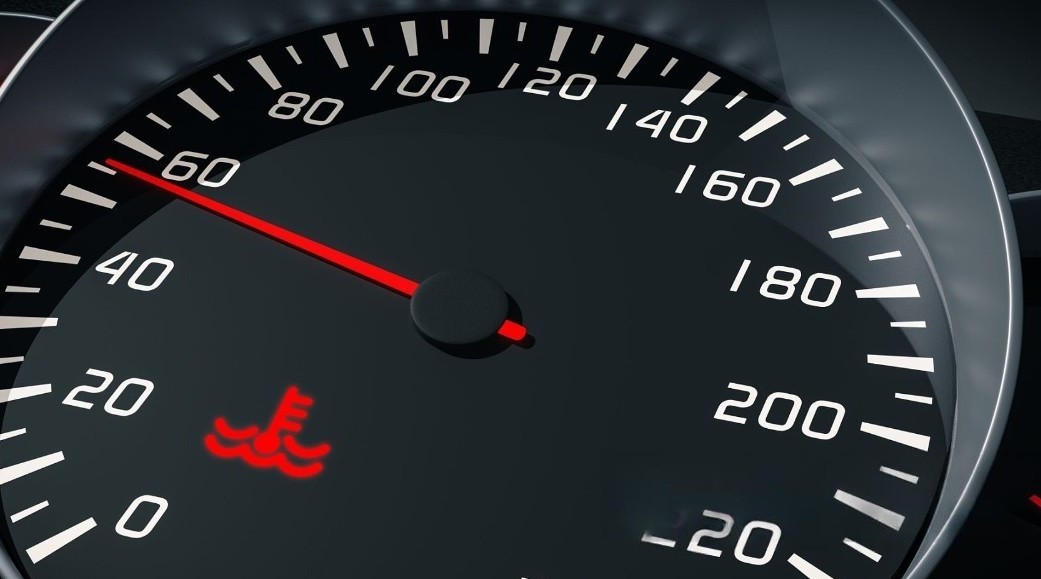
Many riders think any coolant will do, but that’s not true. Some coolants are track‑legal while others will get you kicked off the grid; some offer freeze protection, others don’t. It’s also common to put off coolant changes for years even though most manufacturers recommend flushing every two years or 24,000 miles. Another myth is that all coolant is safe for motorcycles. Automotive antifreeze often contains silicates that can damage a bike’s water pump, so sticking with a motorcycle‑specific blend is smart. Finally, many riders believe running straight water is the ultimate cooling hack. While water transfers heat well, it offers no corrosion or freeze protection, and some tracks now require non‑glycol coolants because spilled antifreeze is slick and dangerous.
Choosing the Right Coolant for Your Motorcycle
Before we dive into our top picks, here’s how to choose the right formula for your bike and riding style:
- Riding conditions. Race bikes and dirt bikes need coolants that shed heat fast and satisfy track‑safety rules. Street machines and touring bikes benefit from antifreeze properties for cold mornings and long service intervals.
- Base chemistry. Traditional ethylene‑glycol formulas provide excellent freeze protection but can be slippery when spilled. Propylene‑glycol blends are non‑toxic and often transfer heat better. Water‑based racing fluids ditch glycol entirely to satisfy track rules and lower engine temps, but they offer no freeze protection and need annual replacement.
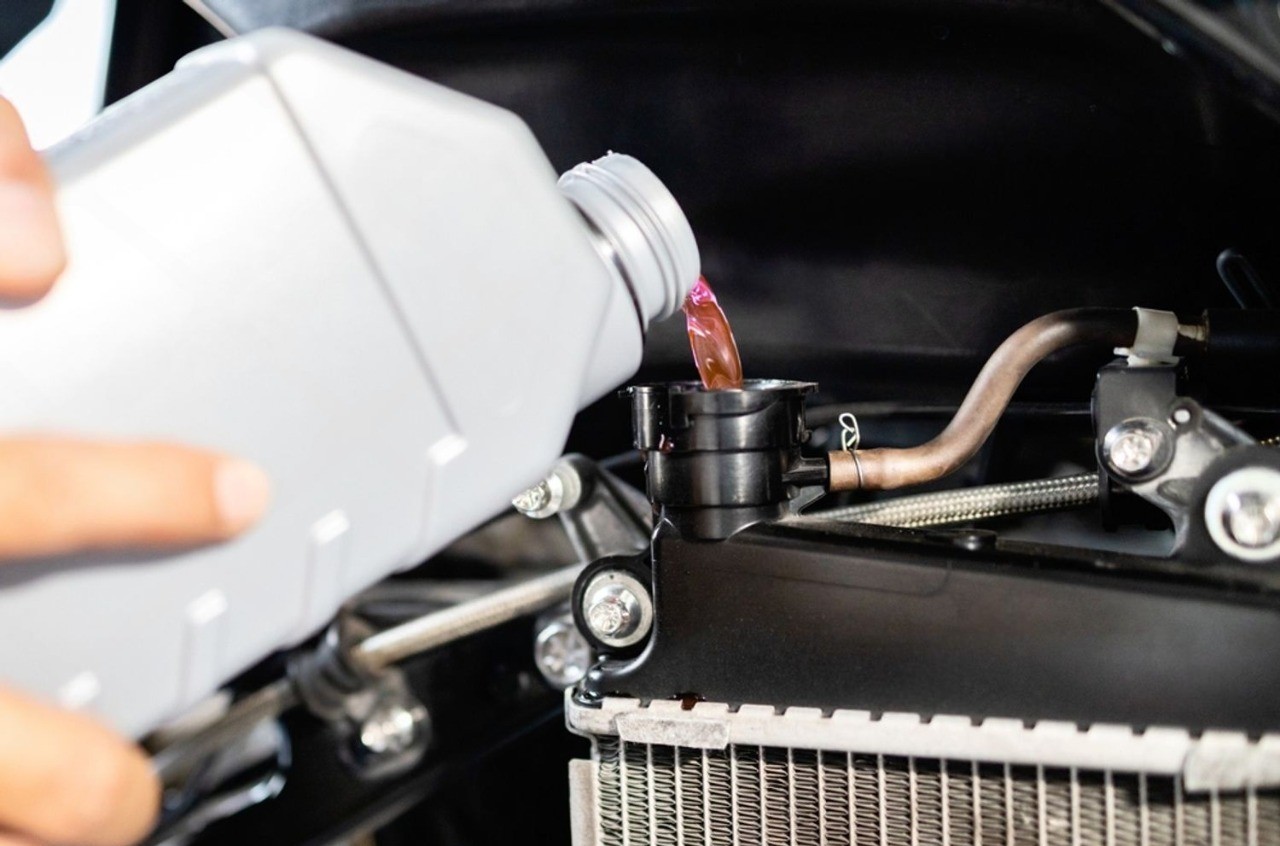
- Waterless coolants. Evans’ waterless formulas run at higher boiling points (above 375 °F) and eliminate corrosion. They’re great for extreme heat and high‑performance engines but require a complete system conversion and aren’t allowed at some racetracks.
- Climate. If you ride year‑round, pick a coolant that protects below freezing. Riders in tropical climates can opt for racing blends that maximize heat transfer because freeze protection is irrelevant.
- Maintenance. Whichever coolant you choose, follow service intervals. RevZilla’s guide suggests flushing and replacing coolant every two years.
You can also monitor coolant temperature alongside maps and telematics — see how we map engine vitals in our Motorcycle Navigation gear guide.
With those factors in mind, here are the coolants we trust when running tours, hammering down racetrack straights and commuting through city traffic.
Best All‑Around Coolant: Engine Ice High Performance Coolant
Category: Everyday & spirited street riding
Engine Ice has become the go‑to coolant for riders who want one bottle that works everywhere. It’s biodegradable and phosphate‑free, so it’s kinder to the environment and safer if a hose ruptures. The formula is also non‑toxic and reduces operating temperatures by up to 50 °F according to Engine Ice. Riders we’ve spoken to on tour noticed their fan cycling less often on hot climbs.
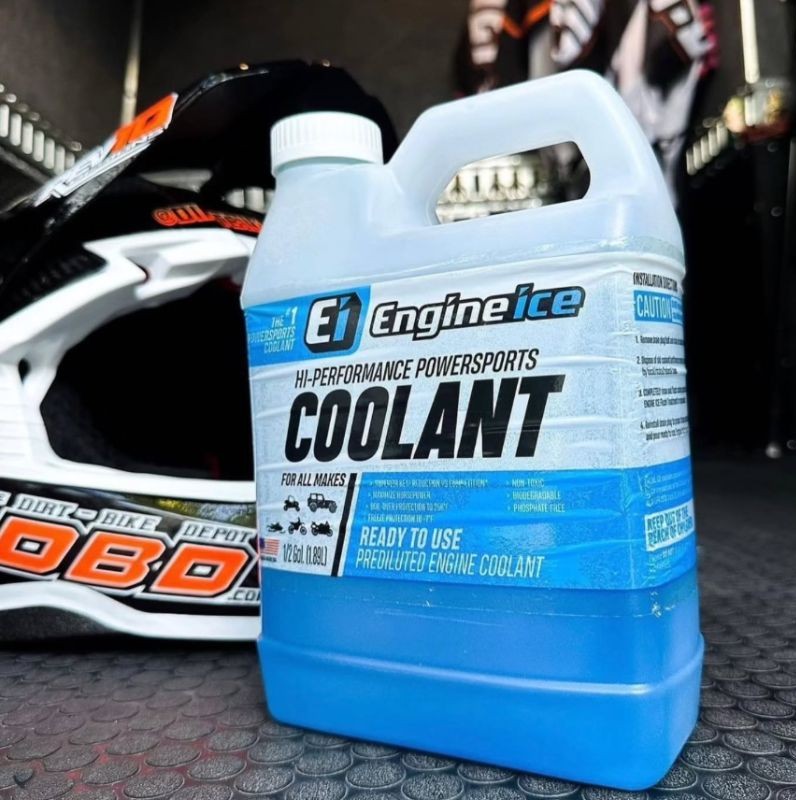
Why does it work? The blend reduces surface tension so it wicks heat off engine parts quickly. It also resists boil‑over up to 256 °F and offers freeze protection down to –7 °F. Because it’s premixed, you don’t have to fiddle with ratios—just pour it in and ride. The coolant is road‑race legal in AMA, CCS and FUSA sanctioning bodies, making it versatile for both track days and daily commutes. Engine Ice is also tested on exotic metals, so those fancy magnesium side cases are safe.
A ready-to-use, biodegradable propylene-glycol formula engineered to reduce operating temps, resist boil-over (256 °F), and stay track-legal without the dangers of slippery spills.
- Great heat-leeching performance under load
- Safe for aluminum and mixed-metal systems
- Non-toxic and biodegradable in unused form
- Track-legal due to low-slippage design
- Requires system flush before switching to it
- Temperature readings may fluctuate under heavy loads
Riders back up the claims. On Engine Ice’s own site, a CBR600RR owner says the coolant made a noticeable difference in keeping temperatures stable during track sessions; another rider’s side‑by‑side (SXS) ran 6–8 °F cooler in desert dunes. A third rider mentions switching because the coolant is biodegradable and less sticky than factory antifreeze—handy when spills happen.
Silver lining: Some riders are put off by the price versus generic automotive coolant. However, generic formulas can contain silicates and phosphates that damage water‑pump seals and aren’t race‑legal. Engine Ice’s performance and safety justify the cost.
Best Track‑Ready Coolant: Engine Ice Pure Performance Racing Coolant
Category: Racing & high‑performance track days
If you’re chasing lap times and need every advantage, Engine Ice Pure Performance is the weapon of choice. This glycol‑free coolant is engineered for racing, and the company describes it as a “heat‑slaying ninja” for its ability to lower surface tension and shed heat quickly. Because there’s no glycol, it’s legal at race tracks that ban slippery antifreeze.
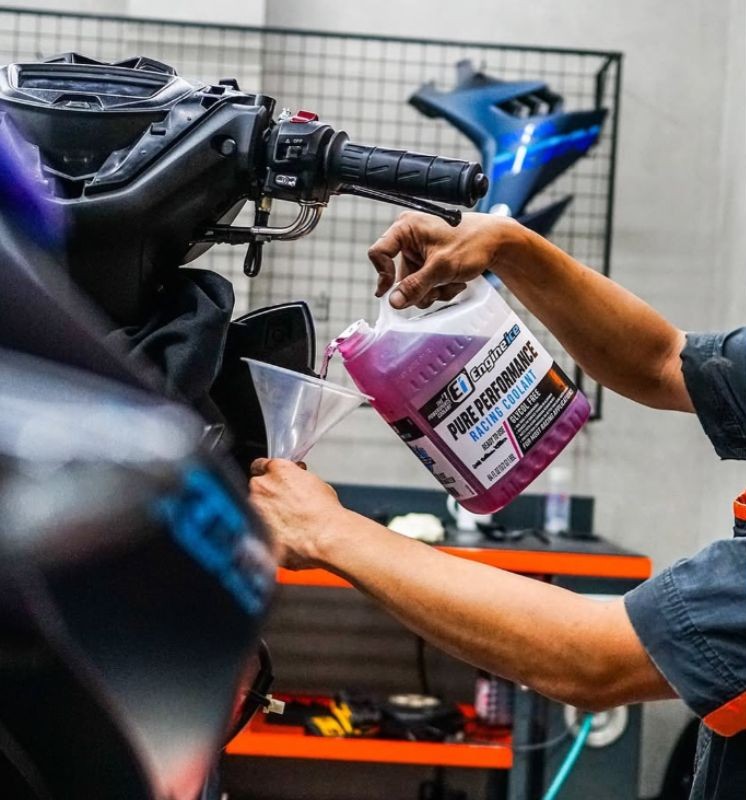
The mixture comes ready to use, and Engine Ice states that it protects against corrosion ten times better than water alone. Importantly, it isn’t an antifreeze — you’re trading freeze protection for maximum heat transfer. The formula is non‑toxic, doesn’t contain 2‑ehoxyethanol (2EH) which can attack rubber seals, and is legal for most racing organizations.
On track, riders have noted in forums and reviews that engines cool down faster between sessions when using Pure Performance, with temperature drops visible within minutes of idling in the pits. According to customer feedback on RevZilla and Engine Ice’s official site, the coolant helps bikes run noticeably cooler during back-to-back laps. Because it’s glycol-free, any spills clean up easily and don’t leave the slippery residue typical of antifreeze.
A pre-mixed, glycol-free racing coolant that lowers surface tension on aluminum surfaces, accelerates heat dissipation, and offers up to 10× corrosion protection — ideal when freeze protection isn’t needed.
- Better heat transfer on aluminum surfaces
- 10× corrosion protection vs. plain water
- Non-toxic and safe around hoses and seals
- Comes ready to use — no mixing required
- No antifreeze properties — not for cold climates
- Needs annual replacement for peak performance
Downside: The lack of antifreeze means this isn’t ideal for winter street riders, and you should flush it once a year to maintain performance. For mixed street and track duty, the standard Engine Ice may be a better compromise.
Best Budget Antifreeze: Maxima Coolanol Coolant
Category: Commuters & touring bikes
Not everyone needs a racing coolant. Maxima’s Coolanol is a ready‑to‑use ethylene‑glycol blend designed to increase cooling capacity and raise your system’s boiling point. It’s free of nitrates, amines and borax, protecting your engine’s aluminum and magnesium parts from corrosion. Riders who value ease of use will appreciate that the 50/50 mix doesn’t require dilution.
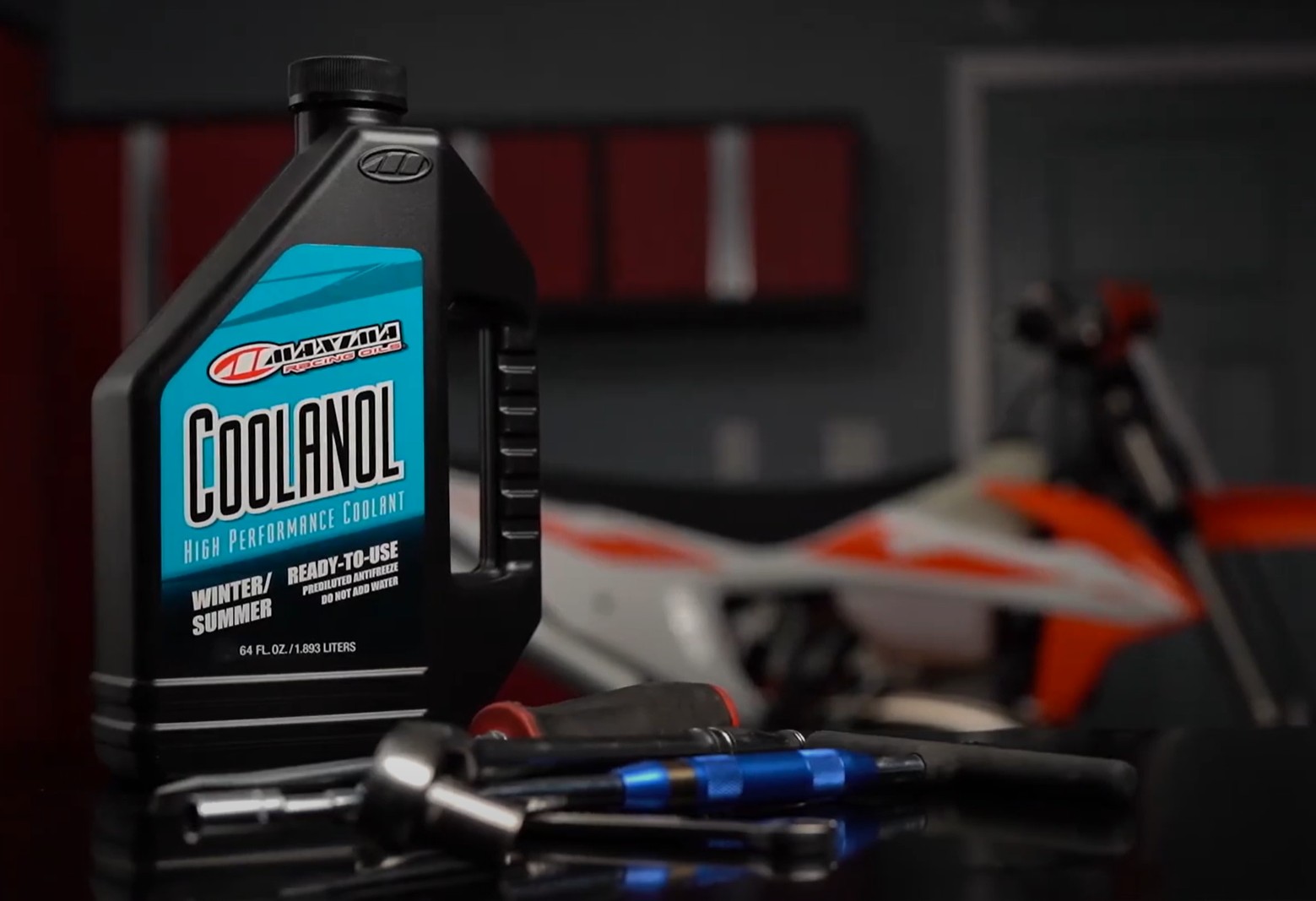
Riders in tropical climates report that Maxima Coolanol keeps commuter and touring bikes—like the Yamaha NMAX and Honda ADV 150—running steadily in heavy traffic and hot weather. Reviews on RevZilla highlight its stable temperatures in urban use and its reliable performance during long rides. The coolant’s 50/50 ethylene-glycol blend also offers freeze protection for riders who travel to cooler regions. According to Maxima, Coolanol is 100 % biodegradable when unused, making disposal more environmentally friendly.
A ready-to-use 50/50 ethylene-glycol blend coolant offering corrosion protection, anti-foam performance, and freeze defense down to –34 °F, suitable for aluminum and magnesium engines.
- Excellent corrosion and rust protection
- Reduces water pump cavitation
- Protects against freeze-ups to –34 °F
- Pre-mixed and easy to install
- Contains glycol — not allowed at all tracks
- May not cool as aggressively as specialty race fluids
Potential drawback: Being glycol‑based, Coolanol isn’t permitted at some racetracks, and if spilled it can be slippery. But for daily riders who prioritize affordability and all‑season protection, it’s a solid choice.
Best Value Race Blend: Maxima Cool‑Aide Coolant
Category: Off‑road & amateur racers
Cool‑Aide is Maxima’s answer to the question “how can I drop my temps without spending a fortune?” The premixed 64‑oz bottle is a blend of deionized water and powerful heat‑transfer additives that significantly reduce engine temperatures. Riders like that it provides better contact on hot surfaces, improving the efficiency of radiators and cylinder heads.
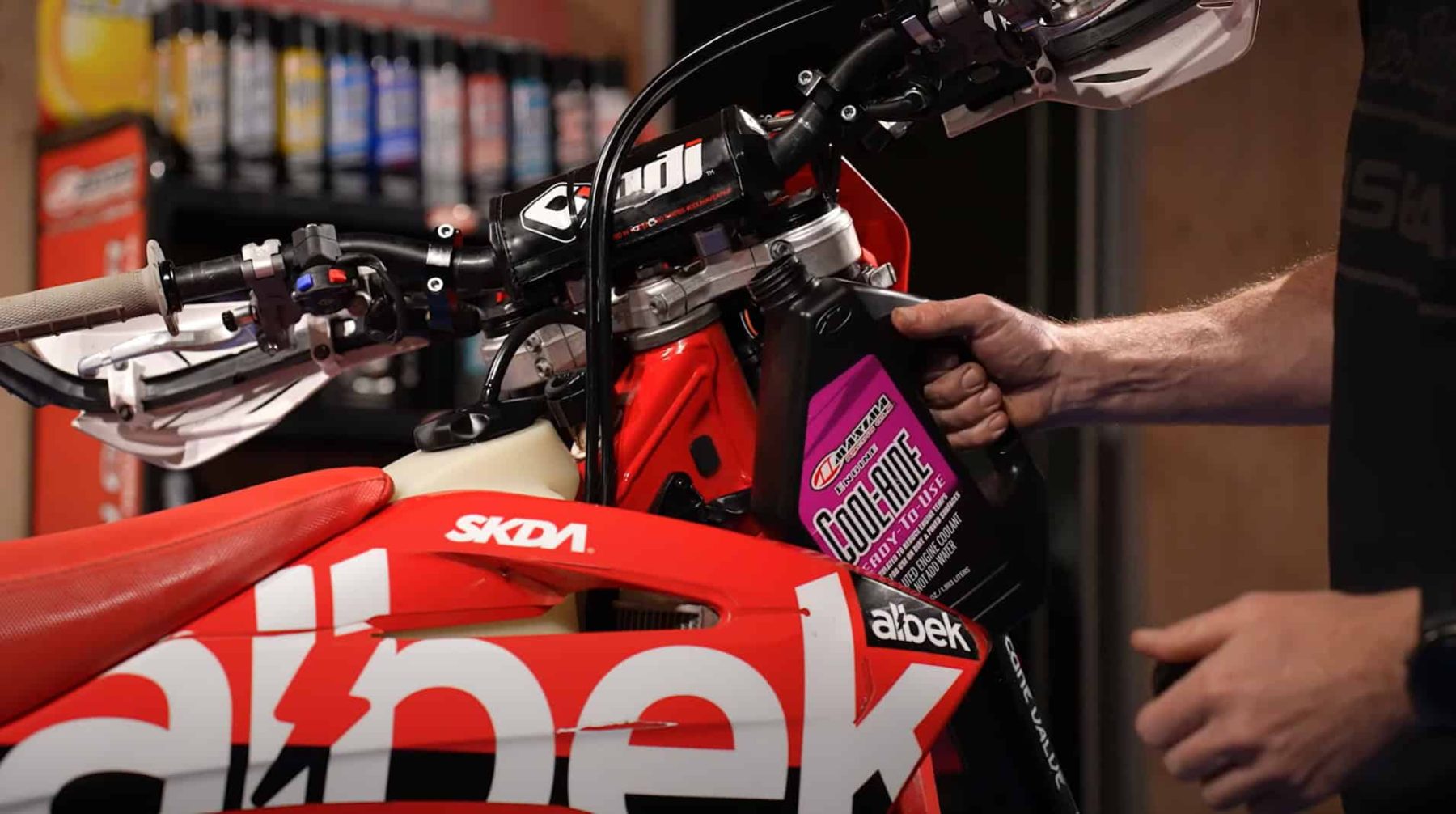
Because it’s glycol, nitrate, amine and borax free, Cool‑Aide is approved for racing on paved surfaces. It’s also 100 % biodegradable in its unused form, protects against rust and corrosion, and lubricates the water pump. The catch? Cool‑Aide does not offer freeze protection, so it’s best for warm climates or track bikes that don’t see cold storage.
Off-road riders report using Maxima Cool-Aide in their two-stroke dirt bikes to lower head temperatures on long climbs without running into issues at motocross tracks. User feedback on RevZilla and dirt-bike forums often notes smoother temperature control and consistent cooling during slow, high-load rides. For riders who occasionally race and mostly ride for fun, it’s a cost-effective way to keep engine temps in check.
A pre-mixed, glycol-free racing coolant that enhances heat transfer, resists corrosion, and meets many competitive track rules without posing slip hazards.
- Improves thermal efficiency under load
- Non-slippery in spills on paved surfaces
- Protects against rust and corrosion
- 100 % biodegradable when unused
- Offers no freeze protection for cold climates
- Needs full system flush to switch from glycol fluids
Silver lining: If you need freeze protection, pair Cool‑Aide with a glycol antifreeze for winter storage or choose Maxima Coolanol instead. Cool‑Aide mixes with water and antifreeze, making this an easy upgrade.
Best Heat‑Transfer Champion: Bel‑Ray Moto Chill Racing Coolant
Category: Sport bikes & high‑horsepower engines
Bel‑Ray’s Moto Chill is unique because it uses non‑toxic propylene glycol instead of traditional ethylene glycol. This special formula transfers heat better, so engines run cooler. The coolant is pre‑mixed and ready to use, and it protects aluminum and magnesium components from corrosion. Bel‑Ray also notes that Moto Chill extends the life of cooling systems and is compatible with common coolants.
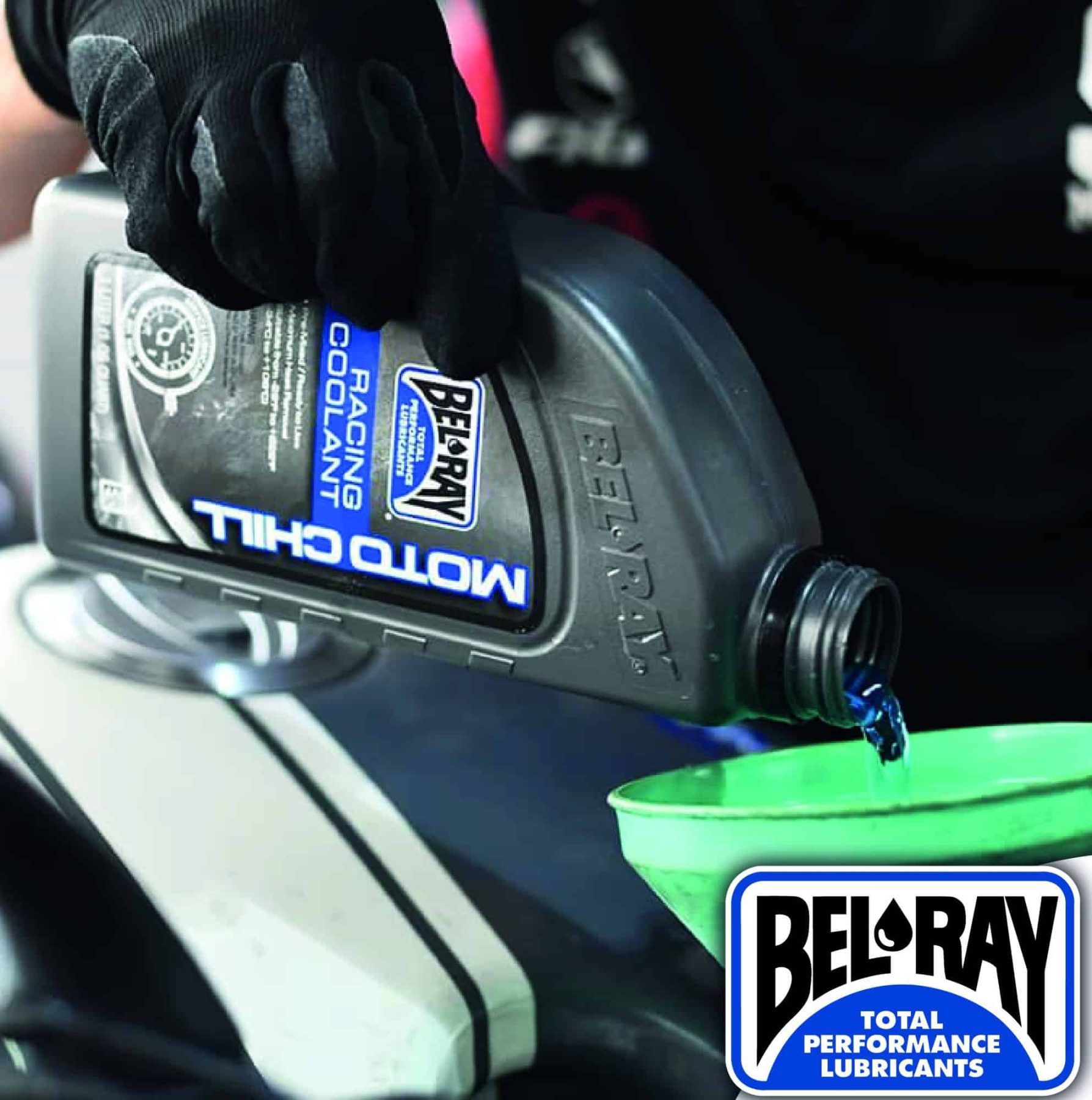
Riders who’ve used Bel-Ray Moto Chill report noticeable improvements in cooling performance on sport bikes with high-compression engines. Reviews on RevZilla and Bel-Ray’s official site mention lower temperature readings during extended track sessions, with gauges often sitting a bar or two cooler than with standard coolant. Another advantage frequently cited is that propylene glycol is less slippery than ethylene glycol, making it safer and easier to clean up in the event of a spill.
A ready-to-use propylene-glycol formula designed for superior heat transfer, corrosion protection, and safer spills — especially suited for high-stress sport and racing use.
- Improves heat dissipation on high-load engines
- Safe for aluminum, magnesium & mixed metals
- Less slippery than ethylene-glycol spills
- Pre-diluted — no need to mix
- No strong freeze protection for cold regions
- Requires complete flushing when switching from glycol fluid
Trade‑off: Moto Chill’s propylene glycol doesn’t protect against freezing as well as ethylene glycol, so winter riders should look elsewhere. If all‑season use is important, Maxima Coolanol or Evans Powersports may be better options.
Best Temperature Dropper: Red Line SuperCool with WaterWetter
Category: High‑performance street & track riders
Red Line is known for its WaterWetter additive, and this pre‑mixed coolant combines that additive with deionised water for easy pouring. WaterWetter doubles the wetting ability of water, reducing or eliminating vapor bubbles that form on hot surfaces. That means heat transfers directly into the coolant and away from your cylinder head, reducing temperatures by up to 20 °F.
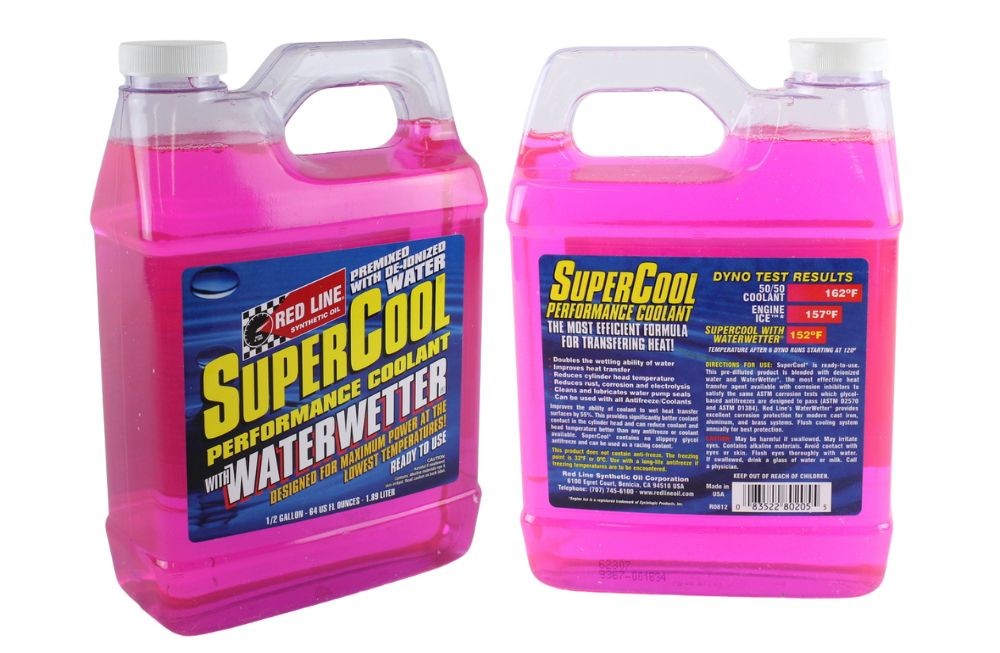
The formula reduces rust, corrosion and electrolysis and lubricates water‑pump seals. Red Line notes it’s compatible with all antifreezes, including DEX‑COOL and long‑life versions. We particularly appreciate that it’s designed for aluminum, cast iron, copper, brass and bronze cooling systems, making it safe for a wide range of motorcycles.
Riders who’ve used Red Line SuperCool in performance bikes such as the KTM 890 Duke report noticeably cooler head temperatures and reduced fan cycling during spirited rides and track days. Reviews on RevZilla and rider forums echo these results, crediting the WaterWetter additive for improved heat transfer and quicker temperature recovery between sessions. Because it’s water-based, SuperCool offers limited freeze protection, though that’s rarely a concern in warm-weather regions.
A pre-mixed coolant infused with WaterWetter that reduces vapor barriers, improves heat transfer, and drops cylinder head temps by up to ~20 °F — compatible with most antifreezes.
- Reduces coolant temperature up to ~20 °F
- Improves heat transfer via anti-bubble action
- Compatible with many antifreeze systems
- Lubricates water pump seals and inhibits corrosion
- Annual flush recommended to avoid buildup
- No extreme freeze protection in very cold climates
Alternative: If you need antifreeze properties, consider mixing Red Line’s WaterWetter additive into ethylene‑glycol coolant. It delivers some of the same heat‑transfer benefits and freeze protection when combined with a 50/50 mix.
Best Track‑Approved Water‑Based Formula: VP Racing Stay Frosty Race Ready Coolant
Category: Race tracks & riders seeking maximum cooling
Some racetracks ban glycol completely because spilled antifreeze is slippery and difficult to clean. VP Racing’s Stay Frosty Race Ready coolant solves that problem by being 100 % water‑based and glycol‑free. It comes pre‑mixed and ready to pour, so there’s no measuring. The formula uses reverse‑osmosis water and special wetting agents, and it can reduce engine temperatures by up to 30 °F.
An article on IMSA’s website explains how Stay Frosty works: its wetting agents lower the surface tension of water, allowing the coolant to make better contact with hot metal surfaces, resulting in 10–20 °F lower overall temperatures or up to 50 °F reduction at the cylinder head. Because there’s no glycol, the coolant is non‑toxic and biodegradable, and spilled fluid wipes up without leaving a slippery mess.
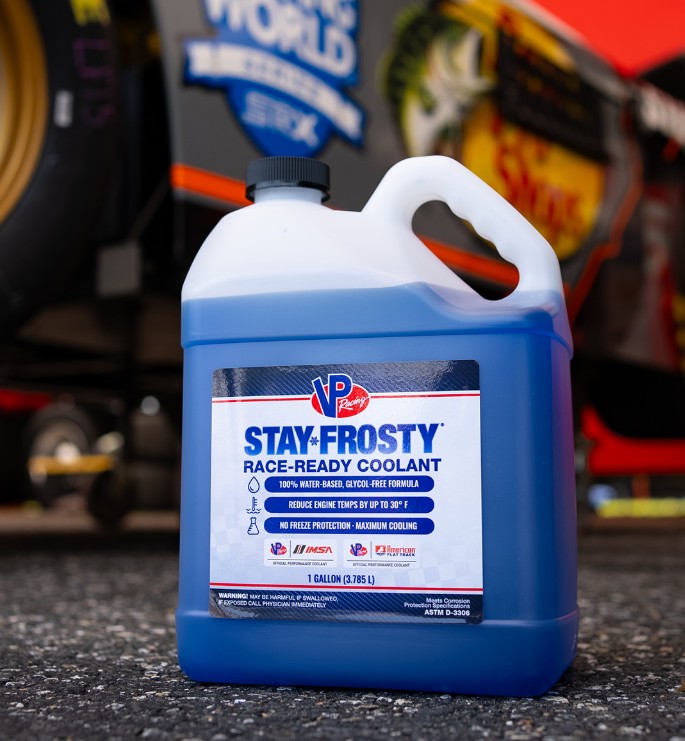
Track-day riders using VP Racing Stay Frosty in sport bikes such as the Suzuki GSX-R750 report significant temperature drops and compliance with strict track regulations. Reviews on RevZilla and performance forums note that engines run cooler and recover faster between sessions, making it a favorite among racers who need a glycol-free coolant. The trade-off is that Stay Frosty offers no freeze protection, so riders in colder climates should store their bikes in warm garages or switch to an antifreeze blend for winter.
A 100% water-based, glycol-free racing coolant that uses multiple wetting agents to cut engine temps (claim up to 30 °F) while staying track-legal and biodegradable.
- Reduces engine temps compared to standard glycol coolants
- Safe on tracks (no slippery glycol)
- Biodegradable and non-toxic when spilled
- Pre-mixed and ready to use (no dilution)
- No freeze protection — unsuitable for cold climates
- Must flush system fully before switching types
Silver lining: For riders who need antifreeze protection but still want VP’s heat-transfer additives, VP Racing also offers a Stay Frosty “Hi-Performance” formula that includes glycol. According to VP Racing and rider feedback on RevZilla, this version delivers a modest temperature drop while retaining the convenience of antifreeze protection for year-round use.
Best Long‑Term Protection: Evans Powersports Waterless Coolant
Category: Adventure & touring bikes in extreme climates
Evans pioneered waterless coolants, and its Powersports formula eliminates water altogether. The result is an incredibly high boiling point above 375 °F and freeze protection below –40 °F. Because there’s no water, cavitation and corrosion are practically eliminated, and the coolant doesn’t build significant pressure in the system. That means hoses and gaskets last longer and your engine is protected from boil‑over on scorching days.
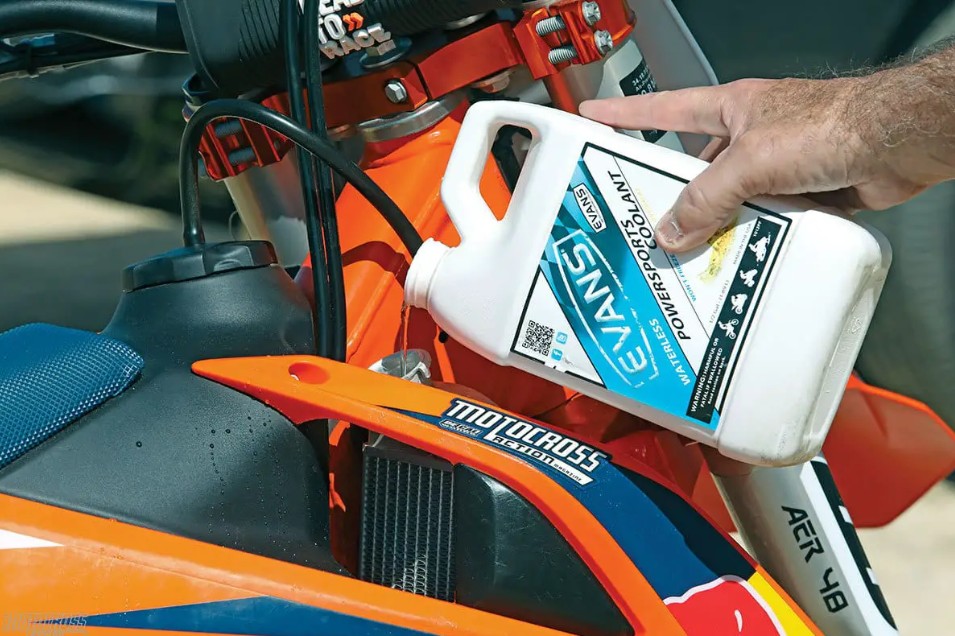
Evans states that the coolant is suitable for all liquid‑cooled engines and is made in the USA. On its official site, Evans adds that the waterless coolant reduces pump cavitation, prevents corrosion and electrolysis, and can increase horsepower by eliminating hot‑spots. Race teams using Evans have reported more consistent power during long stints.
For riders who pair performance cooling with full-on gear setups, check our Best Adventure Motorcycle Gear Revealed to see which jackets, pants, and boots hold up under thermal stress.
A true waterless coolant that stays liquid past 375 °F, protects against corrosion without water, and is made for long-term use with no regular changes.
- Eliminates boil-over risk even under extreme heat
- No vapor pressure build-up—gentler on hoses and caps
- Protects below –40 °F without water
- Minimizes corrosion, cavitation, and electrolysis
- Must fully purge water-based coolant or performance drops
- May reduce heat transfer under some conditions (higher operating temps)
Adventure and touring riders report that Evans Powersports Waterless Coolant performs reliably in extreme conditions—from 40 °C city traffic to high-altitude climbs—keeping engine temperatures stable and preventing boil-over. Reviews on RevZilla and Evans’ official site highlight its consistency during long rides and note that, because it’s waterless, there’s no risk of corrosion or cavitation. Evans also claims the coolant is “lifetime,” meaning it doesn’t require regular replacement once the system is properly converted. However, riders emphasize that switching requires a full flush and use of Evans Prep Fluid to eliminate all traces of water before filling.
Consideration: Evans is more expensive up front and can’t be mixed with water if you need a top‑off on the road. Also, some racetracks ban waterless coolants because they don’t evaporate quickly in a spill. For race bikes, a glycol‑free coolant like VP Racing Stay Frosty may be a better choice.
Comparison Table
| Product | Best for | Key features | Freeze / Boil protection | Track‑legal? |
|---|---|---|---|---|
| Engine Ice High Performance | All‑around street & track | Biodegradable, phosphate‑free, premixed; reduces temps up to 50 °F; non‑toxic; race‑legal | –7 °F / 256 °F | Yes (AMA/CCS/FUSA) |
| Engine Ice Pure Performance | Pure racing & hot climates | Glycol‑free; premixed; corrosion protection 10× better than water; non‑toxic; 2EH‑free; race‑legal | None (coolant only) | Yes |
| Maxima Coolanol | Budget street & touring | Ready‑to‑use ethylene‑glycol blend; increases cooling capacity; nitrate/amine/borax free; biodegradable | Good freeze protection (50/50 mix); boil point raised | Not on all tracks (contains glycol) |
| Maxima Cool‑Aide | Amateur racing & off‑road | Premixed or concentrate; reduces temps; improves heat transfer; glycol/nitrate/amine/borax free; biodegradable | None (no antifreeze) | Yes |
| Bel‑Ray Moto Chill | High‑horsepower sport bikes | Propylene‑glycol formula; better heat transfer; corrosion protection for aluminum/magnesium; ready‑to‑use | Moderate freeze protection; high boiling | Yes |
| Red Line SuperCool | Heat‑sensitive engines & track day riders | Pre‑mixed with WaterWetter; reduces vapor barrier; drops temps up to 20 °F; lubricates water pump; compatible with all metals | Minimal; can mix with antifreeze | Some tracks approve (glycol content low) |
| VP Racing Stay Frosty Race Ready | Race tracks requiring glycol‑free fluids | 100 % water‑based; reduces temps up to 30 °F; non‑toxic; biodegradable; reverse‑osmosis water | None (no freeze protection) | Yes (no glycol) |
| Evans Powersports | Long‑distance & extreme climates | Waterless formula; boiling point >375 °F and freeze protection <–40 °F; eliminates corrosion and cavitation; lifetime fluid | –40 °F / >375 °F | Not always; some tracks disallow waterless fluids |
Buying Guide: How to Maintain and Change Coolant
Changing motorcycle coolant is straightforward but often neglected. Here are a few tips to make the job painless:
- Flush on schedule. RevZilla’s guide recommends flushing your cooling system every two years or 24,000 miles. Old coolant breaks down, loses corrosion inhibitors and can clog passages.
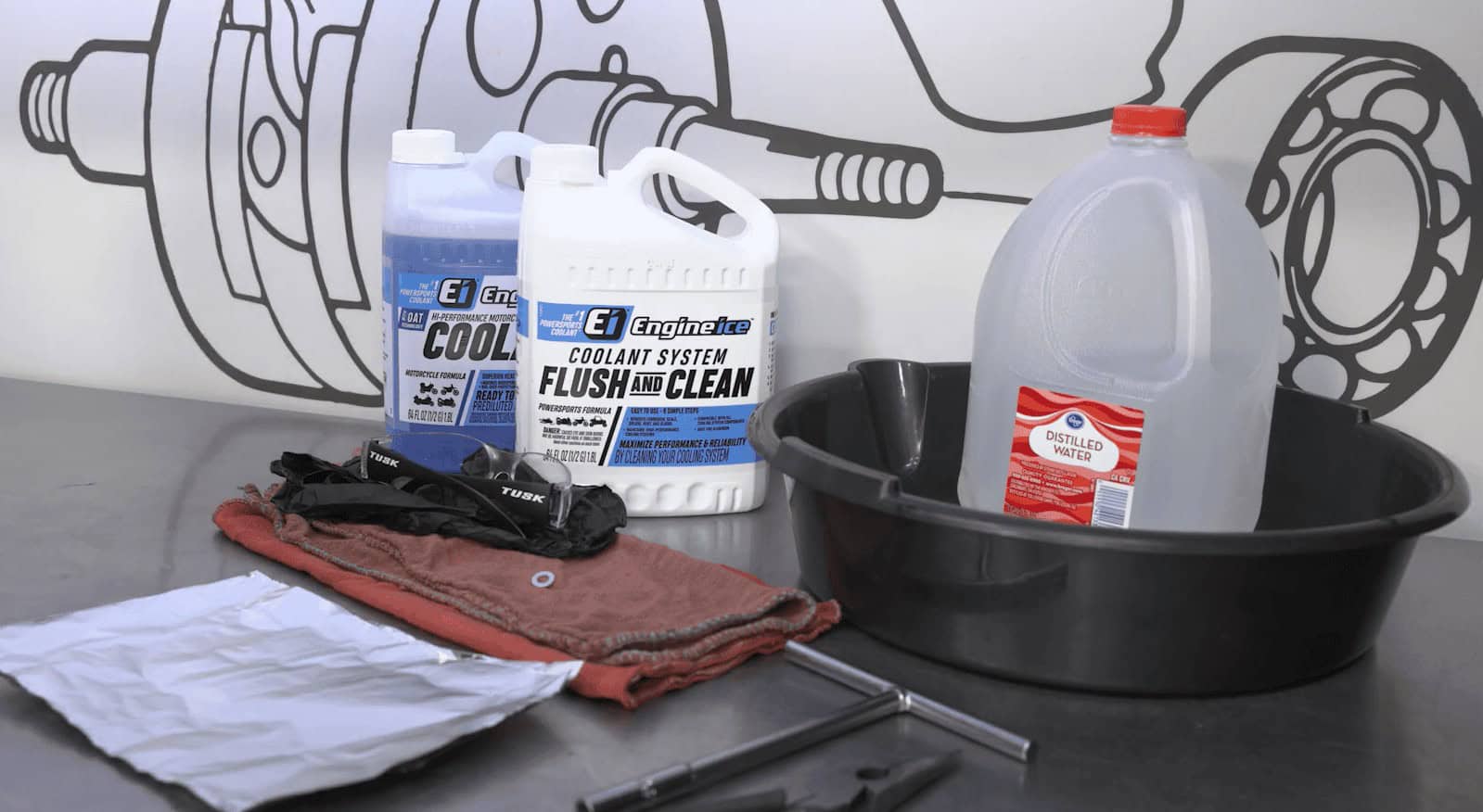
- Use distilled or deionized water. When mixing concentrates, always use distilled water. Tap water contains minerals that can create deposits inside your radiator and promote corrosion.
- Avoid silicates. Automotive antifreeze often contains silicates that can damage mechanical seals. Motorcycle‑specific coolants are generally silicate‑free.
- Bleed the system. After filling, run the engine with the radiator cap off until the thermostat opens. Top off as needed and bleed trapped air per your service manual.
- Dispose responsibly. Ethylene‑glycol coolant is toxic to animals and must be disposed of at a recycling center. Propylene‑glycol and water‑based coolants are safer but should still be collected.
- Check hoses and caps. While you’re in there, inspect hoses for cracks and replace the radiator cap if it doesn’t hold pressure. A fresh coolant won’t help if your system can’t hold it.
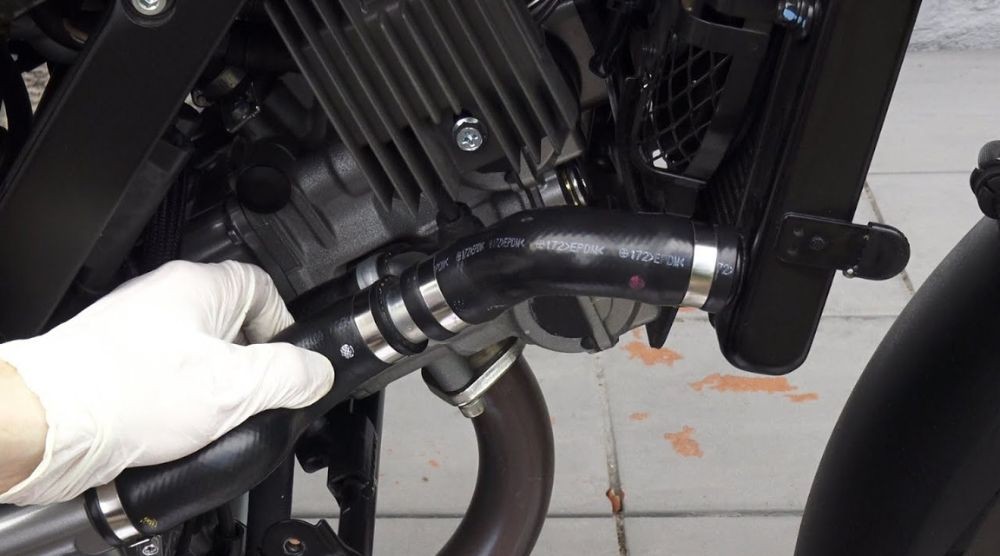
Final Thoughts
Keeping your engine cool isn’t glamorous, but it’s as important as changing your oil. With the right coolant you’ll protect the engine internals, maintain horsepower and avoid surprise melt-downs on your next adventure.
While you’re dialed in on coolant and engine temps, don’t forget the rest of your setup — take a look at our Top Motorcycle Accessories That Work for upgrades that actually matter on the road.
Whether you’re hammering through traffic or chasing lap times at a track day, there’s a coolant on this list to suit your needs. Just remember to follow the maintenance guidelines and your motorcycle will thank you with years of reliable service.
Related
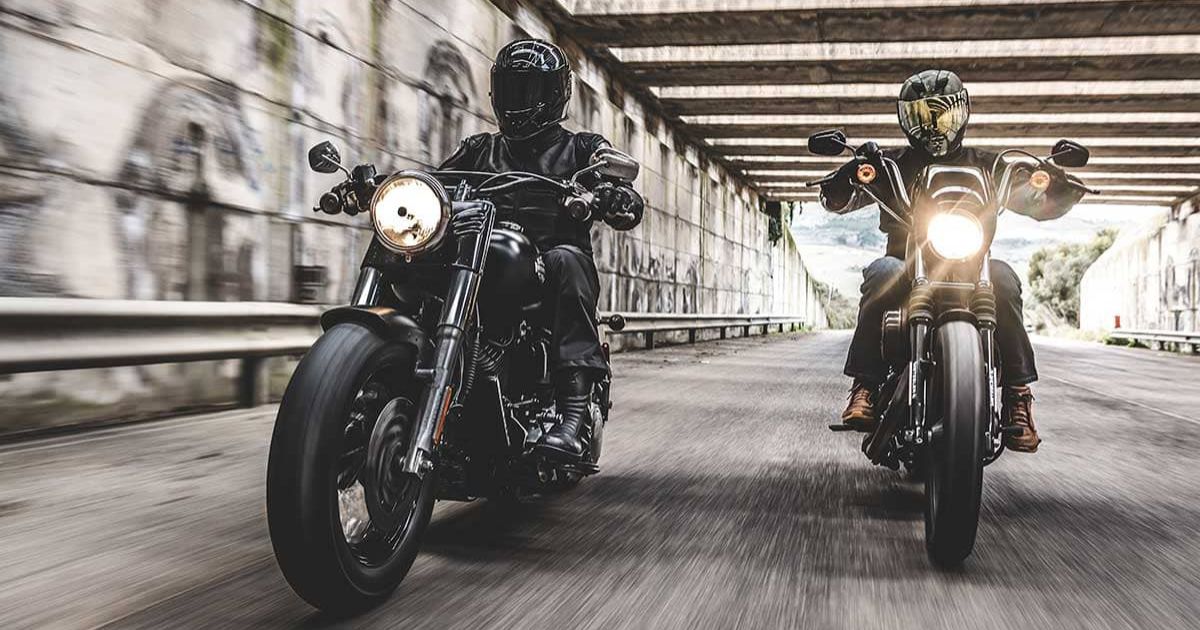
Best Cruiser Tires for Motorcycle Riders in 2025
Discover the best cruiser tires of 2025 for riders—tested for grip, comfort, mileage, and style to keep your V-Twin planted and confident.

